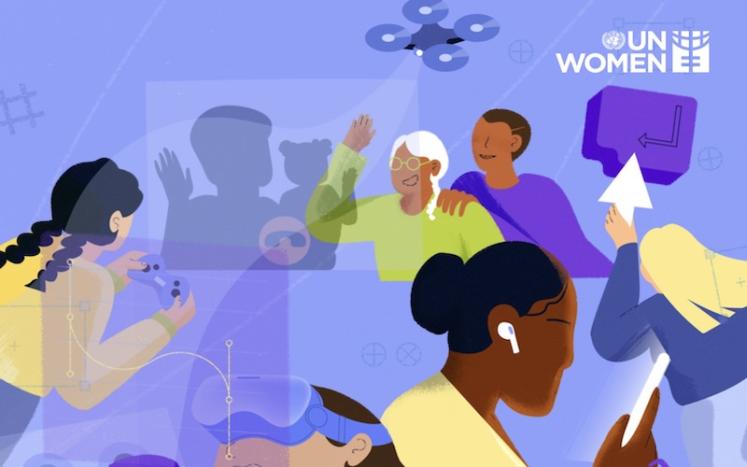Over the last few years there has been increasing interest in the ways in which new technologies affect gender equality, particularly new technologies such as artificial intelligence (AI) that are currently being analysed and regulated globally.
International Women’s Day – focused this year on innovation and technology for gender equality – provides an opportunity to explore the relationship between technology and gender more closely.
This relationship can have both negative and positive implications. On the one hand, AI technologies have, when improperly implemented, presented certain risks for women, notably in relation to insecurity, discrimination, stereotyping, and exclusion. On the other, there have been many examples of AI being used to promote women’s safety and socioeconomic empowerment.
Key to this discussion is the question of women’s representation. Research by the World Economic Forum (WEF) suggests that women represent only about 26 per cent of the data and AI workforce globally. This is also reflected in a ‘digital divide’ – women and girls are less likely to have access to the internet and connective devices, particularly in Least Developed Countries (LDCs).
Women in technology diversify and improve AI systems
This can result in a notable lack of gender sensitivity when it comes to the development of new technologies, exacerbating risks and resulting in a lack of approprtiate technical provisions. For example, AI tools are often less likely to recognize female faces, less likely to recommend hiring women, and less likely to provide loans to women.
This is often due to improper training and testing, rather than malicious intent. However, if women are not present in AI technical and leadership positions, they will be unable to identify and address these types of omissions and advocate for themselves.
The potential of a more inclusive and gender-sensitive technology sector is already evident. There are many examples of tools using AI that include a female perspective to drive innovation and transform women’s lives. These include ride hailing applications, such as Gojek in Indonesia, which includes features to increase women’s safety, such as the biometric identification of drivers and a function that allows a woman’s family and friends to track her trip. In Thailand, a female police investigator also created SisBot – a chatbot which provides legal and psychosocial advice to the victims of sexual violence.
More men in care sectors to share responsibilities
Women’s underrepresentation in technology can be partly attributed to the disproportionate care responsibilities that they take on. This was evident during the Covid-19 pandemic which revealed an immense societal reliance on paid and unpaid care work. Female nurses and care attendants cared for the elderly who were disproportionately affected by the virus, and the mothers of young children, unless they were called away as frontline workers, were often forced to juggle their work and full time childcare.
The additional responsibility of caring for children and vulnerable people, and our gendered employment patterns, means that women are often pulled away from taking on leadership positions, participating in policy making, or contributing to technological innovations.
One solution could be that men take on more care responsibilities – not only unpaid child or elderly care but paid care. While women are underrepresented in technology, men are underrepresented in paid care sectors, such as nursing and elementary-school teaching. Both sides of the representation question are critical to achieving gender equality – increasing the number of men in care and women in technology and leadership positions are complementary and intertwined processes.
Unfortunately, men face discrimination when entering care fields, leading them to be less likely to elect care work, or even obtain employment in these fields. Eliminating these barriers could allow for a shared responsibility in care, with many positive outcomes for gender equality. First, it would reduce the pressure on women to perform most care duties globally, freeing them to increase their engagement in technology (and other) fields. Second, it would provide increased choices for men who would like to engage in paid care work, but don’t feel that they have the option to do so.
Innovation and technology for gender equality
Although there has been a lot of discussion on the distribution of unpaid care work and household duties, there has been less attention on paid care work. At CSW 61 in 2017, for instance, which focused on women’s economic empowerment in the changing world of work, there was much discussion of redistributing responsibility related to unpaid care work – which would allow women to increase their socioeconomic autonomy and engage in paid employment. As we approach CSW 67, however, the debate has moved on to focus on the type of work that women (and men) engage in.
Thinking specifically of efforts needed to increase women’s representation in technology, we could initiate and support networking groups that build women’s capacities, equipping them with the knowledge and skills they will need to enter and thrive in this sector.
We could also increase the representation of men in care fields globally – as a complimentary measure to increase women’s representation in technology – by empowering men to enter care education at younger ages and developing hiring and mentoring programmes to promote and support the hiring of men in care work. In this sense, gender-sensitive innovations not only require a technological transformation but also a societal one.
Suggested citation: Fournier-Tombs Eleonore ., "Redistributing Paid Work between Genders: The Key to Gender Equality?," UNU-CPR (blog), 2023-03-08, https://unu.edu/cpr/blog-post/redistributing-paid-work-between-genders-key-gender-equality.




